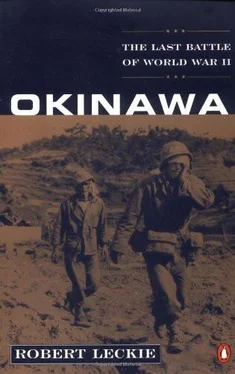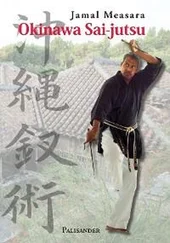As a medic during his regiment’s bitter battle on the Maeda Escarpment in late April, Doss distinguished himself by his utter disregard for his own safety and his devotion to his soldier buddies. Again and again he risked enemy fire to come to the side of stricken GIs, dressing their wounds and then dragging them to the edge of a cliff, where he fastened them to a rope sling of his own devising and lowered them to safety. He did this so often that some of his buddies, believing that he had a charmed life, sought to stay near him. For his gallantry, Doss received the Medal of Honor: a reproach to those who said, “I will not serve,” and a credit to a nation that could bestow its highest military award on a brave pacifist.
Doss was still with the Seventy-seventh on May 11 when that veteran division took on the Chocolate Drop-Wart Hill-Flattop Hill complex in the center of the island. This forbidding position—almost as formidable as Sugar Loaf—bristled with mortars and interlocking machine-guns and 47 mm antitank guns. Because Ushijima had added a protective minefield to its front, the Seventh’s GIs—like the Marines at Sugar Loaf—had to attack without tanks. Casualties were frightful. Colonel Aubrey Smith’s 306th Regiment was bled so horribly that Smith was compelled to form the remnants—that is, about eight hundred men out of twenty-four hundred—into a single battalion. A similar Gethsemane awaited Colonel Stephen Hamilton’s 307th after it relieved the 306th. As Hamilton’s soldiers filed into place, one of them thought that the line of American dead sprawled atop Chocolate Drop looked like a skirmish line ready to leap erect and charge.
As Doss had risked his life on the escarpment, he crawled bravely through enemy fire to succor the wounded. But there his charmed life ended when a bursting mortar shell mangled both his legs. Doss treated his own wounds, waiting five hours for stretcher-bearers to arrive. On the way to the Battalion Aid Station, a fierce enemy barrage drove the bearers to cover. Lying alone on the litter, Doss saw a badly wounded GI untended, rolling from the stretcher to crawl to him and dress his wounds. While waiting for the bearers to return, Doss was hit again in the arm, suffering a compound fracture. Overcoming his horror of touching a gun, this indomitable youth actually made a splint for his arm from a rifle stock, and then squirmed three hundred yards to the aid station, where he was treated and began to recover from his wounds.
Such was the uncommon valor mixed with unique compassion that was common on Okinawa.
On the Twenty-fourth Corps’s eastern flank above Buckner Bay the Ninety-sixth Division was driving against Conical Hill, and also Dick Hill just to the east of Flattop. Here stiff resistance had stalled both GIs of the Seventy-seventh on their division’s extreme left and those of the Ninety-sixth on their own right. But on May 17 an infantry platoon entered over a road cut between Dick and Flattop to explode enemy mines. They used bayonets to detonate the buried explosives—a risky tactic that cost nineteen casualties. In the process they sealed off five caves full of enemy soldiers.
Lieutenant Colonel Cyril Sterner of the 382nd’s Second Battalion realized at once that this lightly defended road was the key to the Japanese position. But it was heavily mined. Ingeniously, Sterner ordered seven tons of bangalore torpedoes—lengths of pipe packed with explosives—laid in the road’s ruts and detonated, thus blasting all the mines. Now tanks could get into the rear of Dick and Flattop, assisted by flamethrowing tanks, and once the Americans were able to make such a penetration they always turned the enemy flank. That was what was done at Flattop and Dick, and by May 21 all that was needed for the Tenth Army to pierce Ushijima’s barrier line was for Colonel Eddy May’s 382nd Infantry of the Ninety-sixth Division to crack that hard nut known as Conical Hill.
Conical Hill was the eminence holding down the easternmost flank of Ushijima’s Naha-Shuri-Yonabaru barrier. If it fell to the Americans, it would unmask Yonabaru, the eastern terminus of the vital Yonabaru-Naha highway. If the Twenty-fourth Corps did succeed in turning it, its troops could then meet the two Marine divisions of the Third Corps at Naha, thus effecting a double envelopment that might trap Ushijima before he could retreat farther south. Because of the importance of this position, General Hodge had chosen Colonel May—his best regimental commander—to direct the attack.
Conical Hill’s importance had not been lost on General Ushijima, and he had stationed one thousand of his finest troops there, confident that they could not be dislodged. Most of them were concentrated in the hills and ridges to the west of Conical, where they expected the enemy to strike. Indeed, that was where May actually attempted his penetration. But the battalion May had assigned to that sector got nowhere in ten days of fighting, while another assaulting Conical’s north face had seized so much ground in two days that both Hodge and Buckner were delighted.
Buckner actually joined May on May 13 to watch the Shermans blasting away at every fissure and crack of Conical’s forward slope. Now E and F Companies of Lieutenant Colonel Edward Stare’s Second Battalion began to move out. Because E was slow getting started, the two platoons forming the spearhead of Lieutenant Owen O‘Neill’s F Company quickly reached their jump-off point. As an indication of the heavy casualties ravaging the Ninety-sixth’s company officers, these units were commanded by two technical sergeants: Guy Dale and Dennis Doniphan. They waited for O’Neill, unaware that his radio was not working. Unwilling to delay longer, they went up Conical on their own initiative. There was little resistance, but the Americans were not deceived. Forward slopes were always a waltz: the real dance of death came screeching out the back door. Yet, to their surprise, not a soldier was hit as they climbed to a point about fifty feet below Conical’s high round peak. Here they began to dig in, for to attempt to take Conical’s tiny indefensible top would have drawn fire from every quarter.
By one of those accidental strokes of luck that so often rule the battlefield, Doniphan and Dale apparently had caught the Japanese in an unguarded moment. Perhaps the enemy had been preoccupied with those western hills. Whatever the excuse, the Americans had been given time to entrench themselves—and it was the chink and clink of those entrenching tools that alarmed Lieutenant Colonel Kensuke Udo. At once he ordered a counter-attack. Out of the reverse slope poured the yelling Japanese, coming full tilt down the forward slope to be hammered to the ground. Now Lieutenant O’Neill joined his men, visibly and vocally pleased by the action of his alert sergeants, immediately calling for the tardy E Company under Captain Stanley Sutten to come up the hill and form a battle front on F Company’s right flank. Two full companies safely entrenched and supported by mortars below now held a perimeter east of Conical’s peak. Oddly enough, the Japanese did not counter-attack that night.
At 383rd’s headquarters a delighted Simon Bolivar Buckner congratulated Colonel May on what he described as one of the finest small-unit maneuvers he had ever witnessed.
During the next three days—May 14, 15, and 16—E and F Companies, now joined by G, fought off the desperately counter-attacking Japanese in a bitter battle on Conical’s forward slope. Gradually the enemy—again charging through their own mortar shells—began to whittle Colonel Stare’s battalion. At last Major General Jim Bradley ordered Lieutenant Colonel Daniel Nolan’s Third Battalion of the 381st Infantry to relieve Stare’s valiant but fought-out Dogfaces. It was a wise decision, for the belligerent Nolan sent his GIs driving down a hogback into Sugar Hill, and with the fall of that strongpoint, Conical Hill was in American hands.
Читать дальше










